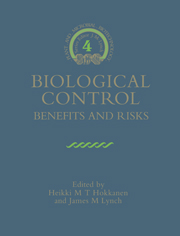Book contents
- Frontmatter
- Contents
- List of Contributors
- Series Preface
- Preface: Overview of Benefits and Risks of Biological Control Introductions
- Part I Biological Invasions
- Part II Classical Biocontrol
- Part III Augmentative Biocontrol
- 9 The Use of Exotic Organisms as Biopesticides: Some Issues
- 10 Use of Trichogramma in Maize – Estimating Environmental Risks
- 11 Entomopathogenic Nematodes in Biological Control: Feasibility, Perspectives and Possible Risks
- 12 Pseudomonads as Biocontrol Agents of Diseases Caused by Soil-borne Pathogens
- 13 Biological Control of Soil-borne Pathogens of Wheat: Benefits, Risks and Current Challenges
- 14 Genetically Engineered Fluorescent Pseudomonads for Improved Biocontrol of Plant Pathogens
- 15 Biological Control of Foliar Fungal Diseases
- 16 The Use of Fungi, Particularly Trichoderma spp. and Gliocladium spp., to Control Root Rot and Damping-off Diseases
- 17 Bacillus thuringiensis in Pest Control
- 18 Opportunities with Baculoviruses
- Part IV Use of Genetically Modified Organisms
- Part V Economics and Registration
- Index
12 - Pseudomonads as Biocontrol Agents of Diseases Caused by Soil-borne Pathogens
Published online by Cambridge University Press: 07 May 2010
- Frontmatter
- Contents
- List of Contributors
- Series Preface
- Preface: Overview of Benefits and Risks of Biological Control Introductions
- Part I Biological Invasions
- Part II Classical Biocontrol
- Part III Augmentative Biocontrol
- 9 The Use of Exotic Organisms as Biopesticides: Some Issues
- 10 Use of Trichogramma in Maize – Estimating Environmental Risks
- 11 Entomopathogenic Nematodes in Biological Control: Feasibility, Perspectives and Possible Risks
- 12 Pseudomonads as Biocontrol Agents of Diseases Caused by Soil-borne Pathogens
- 13 Biological Control of Soil-borne Pathogens of Wheat: Benefits, Risks and Current Challenges
- 14 Genetically Engineered Fluorescent Pseudomonads for Improved Biocontrol of Plant Pathogens
- 15 Biological Control of Foliar Fungal Diseases
- 16 The Use of Fungi, Particularly Trichoderma spp. and Gliocladium spp., to Control Root Rot and Damping-off Diseases
- 17 Bacillus thuringiensis in Pest Control
- 18 Opportunities with Baculoviruses
- Part IV Use of Genetically Modified Organisms
- Part V Economics and Registration
- Index
Summary
Introduction
Progress in agronomy over the last 30 years has allowed world food production to almost double. In part, this was possible through the control of diseases caused by air-borne pathogens. However, the damage caused by soil-borne pathogens has increased during the same period; this has resulted in important yield reduction in protected and unprotected crops. To date, satisfactory methods of control have not been developed. Few plant varieties are resistant to soil-borne pathogens. Unfortunately, crop rotation is often not possible for economic reasons. Pesticides are seldom effective in soil and growing concern for the environment restricts their use. Biological control of root diseases can be considered as an alternative for the future. The pseudomonads are currently receiving attention world-wide because some strains, added at a few grams or milligrams per hectare, effectively increase crop yield and improve plant health. These beneficial effects are well documented, however the mechanisms involved are only partially understood. A better understanding of these mechanisms is crucial to safety if pseudomonads are to be released on a large scale. Data on safety are scarce because the investigation of potential risks associated with the release of pseudomonads has just begun. This review will mainly focus on the results obtained with strain CHAO of Pseudomonas fluorescens.
Beneficial effect of resident populations of pseudomonads
Resident populations of pseudomonads are part of the natural disease suppressiveness of soils and of suppressiveness induced by monoculture or solarization (Smiley, 1979; Scher and Baker, 1980; Rovira and Wildermuth, 1981; Cook and Weller, 1987; Defago and Haas, 1990; Gamliel and Katan, 1991). It is important to realize that natural suppressiveness occurs only in distinct areas.
- Type
- Chapter
- Information
- Biological ControlBenefits and Risks, pp. 137 - 148Publisher: Cambridge University PressPrint publication year: 1995
- 19
- Cited by

